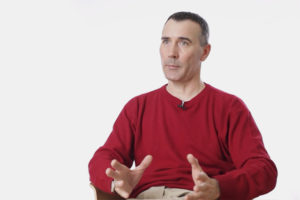Principles of Invention
Microbiologist Kim Lewis on the engineering approach to invention, the perfect solution, and abstracting the p...
When it comes to color and machines with Actor Network Theory (ANT) there is an important concept of the immutable mobile. This is the passage or the inscription of cultural behaviors into the objects that we create to perform these social norms for us. An example that Bruno Latour (creator of ANT) actually used is the automatic door closer. There is a social convention that we open and close doors for each other and we can do it more reliably by building a machine to do that. So the social code has been transferred into a material form in a machine. That’s a very simple example, but there are much broader and more sophisticated examples as well. Production of facts relies on social forces and political contingencies. Tokens then, these things that we put into motion, travel great distances. They can pass through a lot of actors within a network and yet retain a lot of their original forms – they are very durable. Money might be considered one example of that. It circulates, people might write on it, it might get torn, it gets fingerprints and dirt on it. But it does maintain much of its original form.
In a more sophisticated way what ANT theorists explained were things like laboratory equipment – it outlasts experiments or experiments are actually in some ways were designed around, the type of equipment that we have to conduct them with. This equipment participates in a vast economy that extends way beyond the lab and invokes centuries of tradition and material practice.
And authority figures (people, in fact, we can think about anybody in the position of authority) – they work as part of the administrative machinery, they resist individuation in the practice of translation, so they come to occupy a role within the apparatus and in doing that they resist becoming somehow unique. They administrate the translation of any script from one repertoire to a more durable one. Their role is very similar to any other machine in that sense. They prescribed a role for them is to hold the position, to hold the network stable, not to actually allow rearrangement. So machines then become lieutenants and technology reliably replaces the unreliable human activity. People get sick, people change their minds, they make bad decisions sometimes – sometimes good ones, and they become very unreliable. Machines are prone to just do what they told to or else they break down. But their programs include cultural values along with their instructions. And machines perform back to us that which we encode them with, so similarly to the automatic door closer, any machine we look at in some way performs back to us the social convention that we programmed into it.
This is why Philip Venini explained that we must pay as much attention to techne as ethnos. That means that techniques of use has the cultural performativity. This is to examine the ontological implications in the effects rather than causality. So instead of worrying what cause of this to happen, think about what this is actually resulting in.
Bruno Latour explained that actor network theory is unashamedly reductionist and relativist. He is saying there is nothing but networks with no space inbetween them. And adding ontology or the actor into this matrix then modifies the mathematical construct of a network. Specializations, things like close and far, up and down, get replaced by associations and connections. So sketching the properties of actor networks moves from static to topological properties to dynamic and ontological ones. Instead of mapping terrain we are actually looking at the moments of crises and moments of change.
John Law explained that ANT is always intention between the agency, which is the actor, and the structure, which is the network. There is always some kind of struggle between the durability of the material and the kind of agency of the actor to use that in their own way.

Microbiologist Kim Lewis on the engineering approach to invention, the perfect solution, and abstracting the p...

Historian Richard Bourke on the components of nationalism, national identity, and the role of ideology and the...

Sociologist Peter Kivisto on Eugen Weber, settler states, and Jihadist terrorism